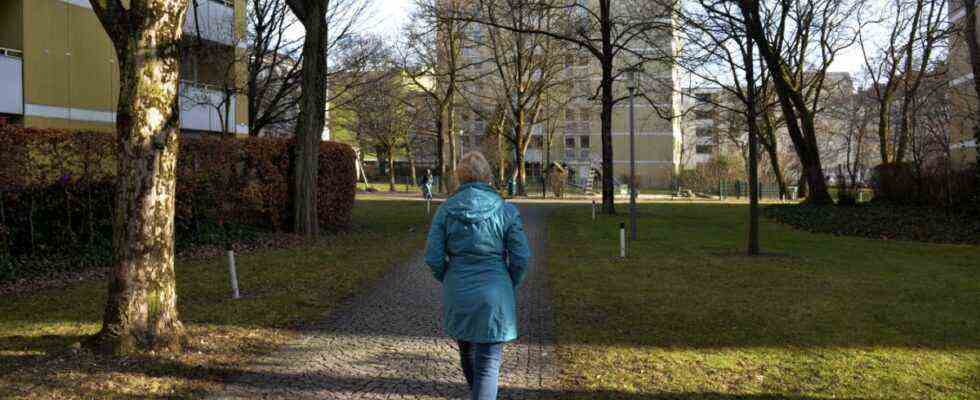Anna Steffny’s apartment is her “little oasis”. The 73-year-old has lived for 23 years in a bright one-room apartment on the second floor of a block on Degenfeldstrasse, with a balcony overlooking a large, green inner courtyard. Even now in winter, the view looks cozy, despite the bare treetops. A year ago, the pensioner had a new kitchen installed for around 5,000 euros.
But now she fears for her home. The reason is an application for a preliminary decision that Steffny’s landlady, Bayern Versicherung Lebensversicherung AG, recently submitted to the local building commission. The planning of the company, which belongs to Versicherungskammer Bayern, envisages densifying the square between Karl-Theodor-, Ansprenger-, Unertl- and Degenfeldstrasse in western Schwabing – in the form of two new buildings that are to be inserted between the existing buildings.
Anna Steffny can still see the green trees from her balcony.
(Photo: Robert Haas)
The construction of another underground car park is also planned. The project is already a revised version: the first version, designed as a continuous block perimeter development, has already been slimmed down by the insurance company due to the massive criticism from the Westschwabing district committee. Instead of the approximately 100 apartments originally planned, only a little more than 50 and no more day care centers are to be built, so that the inner courtyard in Munich’s most densely populated district will not be additionally paved, and aisles for air and light will remain.
However, one of the new six-story low-rise buildings would still dock directly onto Steffny’s window front, provided the plans submitted to the Westschwabing district committee were to be implemented in the near future. And thus take away the only daylight from their retreat and from the flats of their neighbors, which have the same layout, above and below. A scenario that the builder denies. But the tenants are still extremely concerned. “A disaster par excellence,” says Eleonore Bermüller, who lives on the fourth floor. The 86-year-old has lived in the complex for 60 years and has invested her entire savings in her home and had everything custom-made. She is “deeply outraged and worried” about the project: “I don’t intend to move, but to spend the rest of my life here in peace, where I know the people and feel at home.”
Monika Ilg argues similarly. She grew up in the square and consciously moved to this one-room apartment on the ground floor 16 years ago because of her arthrosis. 164 tenants live in the area, which consists of three nine-story tower blocks and a five-story residential block complete with offices and medical practices. They would all be affected by the construction work, albeit to varying degrees.
The insurance board tried to appease that “no windows would be bricked up”
A third of the inner courtyard’s green space would still fall victim to the plans. These include several old trees and a path starting from Degenfeldstrasse, which many Schwabing residents have long used as a welcome link to the Bonner Platz underground station. Surrounded by densely populated and sealed rows of houses, the farm is a paradise for fauna and flora: squirrels live there, as well as many birds, hedgehogs, bats and insects. The green areas filter exhaust fumes, serve as fresh air corridors and cool places in summer.
Sarah Friedrich, for example, “deliberately” moved to Unertlstrasse 23 with her family four years ago because it is “quiet and green and there is a large playground”. Elsewhere in the most densely populated district of Munich, on the other hand, it is “bomb hot” in the summer months. In addition, says the mother, the children could run in this area, be loud, let off steam. “It’s so important – but where else in town is it?”
At the insurance board, the response is reassuring. Company spokeswoman Inge Sommergut assures that “extensions to existing apartments will only be implemented in vacant apartments”. There were no structural interventions in the one-room apartments during the tenancy. Thus, “no windows would be bricked up. And layoffs are excluded.”
The district committee must now decide whether to approve the plans
Sommergut does not want to comment on how the new building is then to be realized. Her colleague Benjamin Forster has already explained to local politician Marina Burwitz, who sits on the district committee for the Greens and also lives at Degenfeldstrasse 14, that the construction project will “possibly be implemented with a time delay”.
And the green? “We have already reduced the planned structural measures in favor of preserving green spaces by almost 50 percent,” says the spokeswoman. This means that the large courtyard area will remain as a recreation area. To compensate, the sealed areas were given greenery on the roofs. A playground will also be created again after the renovation. “In addition, there will be replacement plantings for the approximately 20 trees to be felled.” And instead of the missing path, a passage into the inner courtyard between Degenfeldstrasse 10 and 14 is “conceivable”.
But now the ball is in Westschwabing’s district committee. The citizens’ representatives have to decide whether they approve of the planning and the preliminary decision application – or whether they reject it, as the first version did. The final vote on the admissibility of the project is then up to the local building commission.

